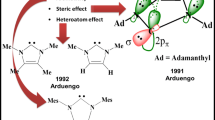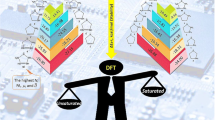Abstract
Following on from our recent enforced geometry optimization (EGO) investigation of isomerization in cis-stilbene (J Comput Chem, in press) we report the discovery of two interesting new, symmetrical “fused sandwich” isomers of both cis-stilbene and the related cis-azobenzene. The isomers were obtained by applying external forces to pairs of carbon atoms from each of the benzene rings in cis-stilbene and cis-azobenzene simultaneously, and are all at least 100 kcal mol-1 higher in energy than the starting material. Each new structure was characterized as a minimum by vibrational analysis. Despite their high energy, all of the new isomers appear to be kinetically stable with respect to rearrangement back to cis-stilbene or cis-azobenzene, respectively.
Similar content being viewed by others
Avoid common mistakes on your manuscript.
Introduction
In previous publications we reported the discovery of several potentially kinetically stable new isomers of C14H12 and C12H10N2 derived from cis-stilbene (1) [1] and cis-azobenzene (2) [2] (see Fig. 1), respectively. They were obtained using enforced geometry optimization (EGO), in which pairs of carbon atoms, one from each of the two phenyl rings, were pushed together along the line joining the two atomic centers, by means of an applied external force [3]. This force is added to the normal gradient vector computed at that geometry at each cycle of a geometry optimization and typically results in bond formation between the atoms involved. All atoms in the system adjust their relative positions so as to counter the external force and the final result of the optimization is usually a new structure, albeit one that is highly strained. Whether the new structure is stable, i.e., represents a local minimum on the potential energy surface, can be determined by carefully reoptimizing with the external force removed. If the new structure is stable, it will relax but remain substantially intact; if not it usually reverts back to the starting structure.
All the kinetically stable isomers found in our earlier work were obtained by forcing together only a single pair of carbon atoms and all lay energetically no higher than 90 kcal mol-1 from the starting material for the stilbene isomers, and under 30 kcal mol-1 in the case of cis-azobenzene. In this communication we report the discovery of some interesting high-energy symmetric “fused sandwich” isomers of both stilbene and azobenzene obtained by forcing together multiple pairs of carbon atoms (in this case all six) from each of the two phenyl rings.
Results and discussion
The standard methodology used in this work is density functional theory (DFT) [4, 5] using the B3LYP hybrid exchange-correlation functional [6, 7] with the 6-31G* basis set [8]. All calculations were carried out using the PQS program package incorporating the PQSMol graphical user interface for post-job visualization and display [9]. All stationary points found at B3LYP/6-31G* were reoptimized at MP2/6-311G** to ensure that the energetics remained stable.
The new isomers, which we call C14H12-Cs, C14H12-C2v, C12H10N2-Cs and C12H10N2-C2v are shown in Fig. 2. They were all obtained by pushing together all symmetry equivalent pairs of carbon atoms from the two phenyl rings in cis-stilbene and cis-azobenzene, respectively. As denoted by the names, the new isomers have either Cs or C2v symmetry. The optimization history for this procedure starting from cis-stilbene using an applied force of 0.1 au is depicted in Scheme 1, below.
As can be seen, the energy initially rises to a maximum, then falls and then starts to oscillate. The calculation did not in fact converge, but simply stopped after reaching the maximum allowed number of optimization cycles. Apparently there is simply too much internal strain in the system for it to settle down. If the geometry corresponding to the highest energy oscillation is taken and allowed to relax (i.e., is reoptimized after removing the external force) then the C2v minimum results; if the lower energy structure is relaxed then the result is the Cs minimum. The situation is similar for cis-azobenzene.
As shown in Fig. 2 the new isomers are symmetrical “fused sandwich” compounds in which the former phenyl rings lay one on top of the other (or side-by-side depending on one’s point of view). In the C2v isomers, every carbon atom in each of the phenyl rings forms a bond to its equivalent atom in the other ring. In the Cs isomers, two of the carbon atoms in each phenyl ring open out and are not bonded to the two equivalent atoms in the other ring. If – as is the case in Fig. 2 – the former ethylene fragment in cis-stilbene and the N=N double bond in azobenzene are oriented so they are at the top of each isomer, then in the Cs isomer the carbon atom at the apex of the former phenyl ring at the bottom is not bonded, together with one of the two carbon atoms connected to the apex carbon. In fact, there are two symmetry-equivalent Cs structures depending on which of the two carbon atoms either side of the apex atom are bonded with a C2v transition state connecting the two equivalent Cs isomers.
We have located C1 structures which appear to be transition states for decomposition of the Cs and C2v isomers, respectively, back to either cis-stilbene or cis-azobenzene. These are depicted in Fig. 3, together with arrows showing the motion of the atoms in the imaginary vibrational mode.
Selected B3LYP/6-31G* geometrical parameters (primarily the inter-ring C-C distances) in all stationary points (four minima and six transition states) are shown in Table 1 and relative energies of all species at both B3LYP/6-31G* and MP2/6-311G** are given in Table 2. All energies are relative to either cis-stilbene or cis-azobenzene as appropriate. The atom labeling used in Table 1 is shown in Fig. 1. External forces were applied between each pair of primed and unprimed carbon atoms labeled 1 through 6. In the C2v minima a new bond was formed between all primed and unprimed carbon atoms; in the Cs minima bonds were formed between primed and unprimed carbon atoms 1, 2, 6 and either 3 or 5 (leading to the two symmetry-related Cs isomers). The labeling in cis-azobenzene is the same, except that N replaces C7.
Both structurally (Table 1; Figs. 2 and 3) and energetically (Table 2) the new C14H12 and C12H10N2 isomers and their transition states are similar to one another. In particular both the Cs and C2v minima appear to be kinetically stable, with barriers to decomposition (B3LYP/6-31G* with MP2/6-311G** values in parentheses) of 38.7 (33.3) kcal mol-1 for C14H12-Cs, 24.0 (30.8) kcal mol-1 for C14H12-C2v, 28.9 (20.9) kcal mol-1 for C12H10N2-Cs and 29.1 (22.5) kcal mol-1 for C12H10N2-C2v. The barrier heights for the Cs-Cs rearrangement are 26.8 (22.5) kcal mol-1 for C14H12-Cs and 27.0 (22.7) kcal mol-1 for C12H10N2-Cs. All quoted values are well-to-well and exclude zero-point effects. As was the case with the other recently reported C14H12 and C12H10N2 isomers [1, 2], nearly all structures are predicted to be more stable thermodynamically but less stable kinetically at the MP2 level than with B3LYP.
The simulated IR and Raman spectra for the four new “fused sandwich” isomers reported here, together with those for cis- and trans-stilbene and ditto azobenzene, are shown in Figs. 4, 5, 6, 7. These were obtained directly from the computed B3LYP/6-31G* force constant (Hessian) matrix, scaled using the five standard precomputed scaled quantum mechanical (SQM) scale factors [10] shown in Table 3, and visualized using the PQSMol graphical user interface available with PQS [9]. All spectra have been partially standardized to aid comparison.
Both the IR and Raman spectra of the four new isomers are dominated by intense bands in the C-H stretching region. These are predicted to be so intense relative to any of the other bands (by a factor of more than 5 in the IR and 20 in the Raman) that the intensity scale has been reduced in order to show detail in the fingerprint region.
For the Raman spectra in particular, although the new high-energy isomers have richer spectra with more bands than the parent compounds (stilbene and azobenzene), the bands in the latter are far more intense (note the intensity scales in Figs. 6 and 7); this, combined with their likely far greater concentration in any mixture containing the new isomers – unless they can somehow be isolated – suggests than Raman spectroscopy is unlikely to be a viable method for detecting the proposed new species. The same holds, albeit to a lesser extent, for IR spectroscopy.
A potentially more useful approach as far as detection is concerned may be NMR. Table 4 gives the (absolute) B3LYP/6-31G* 13C and 1H chemical shifts computed for cis- and trans-stilbene, C14H12-Cs and C14H12-C2v, and Table 5 reports the same for the corresponding azo compounds. As can be seen there are substantial shifts upfield (averaging about 90 ppm) on all phenyl carbon nuclei in the C2v isomer and on two thirds of them in the Cs isomer. (Basically every carbon atom involved in bond formation is shifted upfield.) The carbon atoms in the formal ethylenic C=C double bond shift downfield compared to cis-stilbene by about 15 ppm. The situation in the azo compounds is similar with again any phenyl carbon atom forming a new bond shifted upfield by around 90 ppm and the 15N signal shifting downfield relative to cis-azobenzene by about 70 ppm.
The effect of bond formation can also be seen in the proton chemical shifts, with any hydrogen attached to a bonding phenyl carbon shifting upfield by around 4 ppm. The fact that these shifts are substantial and are uncontaminated in this region of the NMR spectrum by any signals from the parent compounds should be a tremendous aid to detection. However, care needs to be taken as other lower energy stilbene and (presumably) azobenzene isomers, formed theoretically by applying external forces to single pairs of phenyl carbon atoms [1, 2], also have similar such shifts (albeit not so many).
Conclusions
In this work we have reported on the discovery of two structurally very interesting, new high energy but potentially kinetically stable, symmetrical “fused sandwich” isomers of both cis-stilbene and the related cis-azobenzene. We have presented simulated IR and Raman vibrational spectra of all four of the new isomers and indicated how they can be distinguished from the parent compounds, cis-stilbene and cis-azobenzene, by NMR spectroscopy.
Neither of the authors are experimental chemists and so we cannot suggest any practical method to make these compounds, but once again the theoretical approach utilized here, enforced geometry optimization [2, 3], has demonstrated that it is a very useful and powerful tool for discovering potentially new chemical structures.
References
Baker J, Wolinski K, J Comput Chem, in press
Wolinski K, Baker J (2009) Mol Phys 107:2403–2417
Wolinski K, Baker J (2010) Mol Phys 108:1845–1856
Hohenberg P, Kohn W (1964) Phys Rev B 136:864–871
Kohn W, Sham L (1965) Phys Rev A 140:1133–1138
Becke AD (1993) J Chem Phys 98:5648–5652
Hertwig R, Koch W (1997) Chem Phys Lett 268:345–351
Ditchfield R, Hehre WJ, Pople JA (1971) J Chem Phys 54:724–728
PQS version 4.0, beta, Parallel Quantum Solutions, 2013 Green Acres Road, Suite A, Fayetteville, Arkansas 72703, U.S.A. Email: sales@pqs-chem.com; URL: http://www.pqs-chem.com
Baker J, Jarzecki AA, Pulay P (1998) J Phys Chem A 102:1412–1424
Open Access
This article is distributed under the terms of the Creative Commons Attribution Noncommercial License which permits any noncommercial use, distribution, and reproduction in any medium, provided the original author(s) and source are credited.
Author information
Authors and Affiliations
Corresponding authors
Rights and permissions
Open Access This is an open access article distributed under the terms of the Creative Commons Attribution Noncommercial License (https://creativecommons.org/licenses/by-nc/2.0), which permits any noncommercial use, distribution, and reproduction in any medium, provided the original author(s) and source are credited.
About this article
Cite this article
Baker, J., Wolinski, K. Kinetically stable high-energy isomers of C14H12 and C12H10N2 derived from cis-stilbene and cis-azobenzene. J Mol Model 17, 1335–1342 (2011). https://doi.org/10.1007/s00894-010-0835-0
Received:
Accepted:
Published:
Issue Date:
DOI: https://doi.org/10.1007/s00894-010-0835-0












